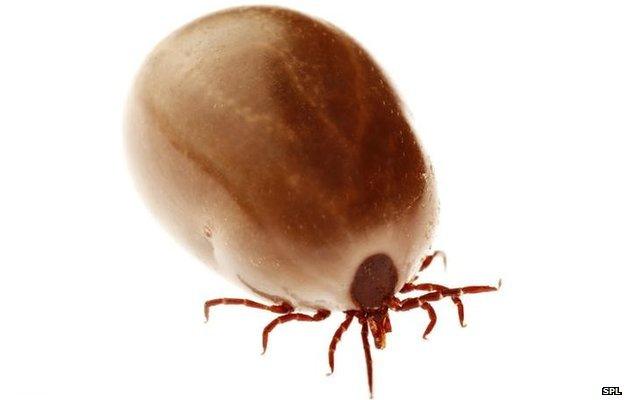Who, What, Why: How dangerous are tick bites in the UK?
- Published

Walkers are being warned to protect themselves against tick bites after a wet and mild winter. Just how dangerous are ticks, asks Vanessa Barford.
Experts have warned, external that ticks - blood-sucking, disease-carrying arachnids - appear to be on the rise in the UK.
Richard Wall, professor of Zoology at Bristol University, says there's no definitive data on how many ticks are in the country. Some areas have none. Others - usually woodland and heath areas - may have more than 100 per square metre. However, the general consensus among rural communities is they are on the up, largely as a result of the warmer and wetter weather (good breeding conditions) and the growing number of wild deer (ticks like living on their skin).
The number of confirmed cases of Lyme disease - the most serious bacteria infection spread to humans by infected ticks - has also increased, according to Dr Tim Brooks, head of the Rare and Imported Pathogens Laboratory. He says laboratory proven cases have risen from about 200 in the late 1990s, to 1,200 last year, although the actual number of cases is probably three times that. Awareness and testing of the disease has also gone up, so the figures have to be seen in that context, he adds.
Lyme disease is treatable with antibiotics if it's diagnosed early. But neurological problems and joint pain can develop months or years later if it's left untreated. In the worst cases, it can be fatal.
The most common symptom is a pink or red circular "bull's-eye" rash that develops around the area of the bite, but it doesn't appear in everyone. Flu-like symptoms and fatigue are other noticeable signs of infection.
Public Health England, external says the best way for walkers to avoid getting bitten is to use repellent, wear light coloured clothes so that ticks can easily be seen and walk on paths and avoid long grass or verges. Dog walkers are also advised to check their pets as ticks spread other diseases as well as Lyme disease to animals as well.
For those worried about their gardens, keeping lawns short, raking up leaf litter and creating a buffer zone between habitats ticks tend to like and lawn-paving, wood chips and gravel can help.
However, Prof Wall says a very small proportion of ticks carry Lyme disease.
Dr Brooks says the disease is a far bigger problem in other parts of Europe and the US, especially on the East Coast.
The most important thing is for those that think they might have symptoms of Lyme disease to go to the GP as prompt treatment will prevent complications. Symptoms usually take between three days to six weeks to appear after a tick bite.
And for those unsure how to remove a tick? Use fine tipped tweezers, or a tick-removal tool, to grasp the tick by the head as close to the skin as possible. Pull firmly and steadily, without twisting, as this could increase the risk of infection by prompting the tick to regurgitate saliva into the bite wound.
After the tick is removed, apply antiseptic and beware of a rash.
Follow @BBCNewsMagazine, external on Twitter and on Facebook, external